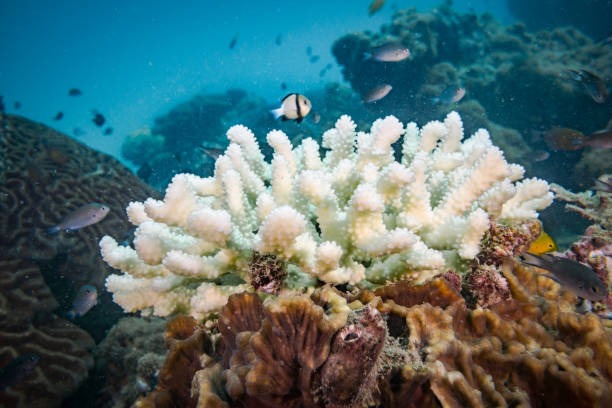Ocean Acidification: A Silent Crisis
Immediate action is needed to address the root cause and adapt to its ongoing effects to ensure the preservation of healthy oceans and dependent communities.


Introduction
Ocean acidification is a pressing environmental issue with significant implications for marine ecosystems, biodiversity, human health, and potential solutions to mitigate its effect. The following report presents organized insights into various aspects of ocean acidification.
Cause of ocean acidification
Ocean acidification primarily arises from increasing levels of carbon dioxide (CO2) in the atmosphere, which dissolves in ocean waters and leads to a decrease in pH levels [1]. Human activities such as burning fossil fuels, deforestation, and cement production are the main contributors to rising CO2 levels [2]. The continuous rise of CO2 since the industrial revolutions has resulted in approximately 30% of the emissions being absorbed by oceans, making them 30% more acidic than they were at that time [3].
Effects on the marine ecosystem
Ocean acidification poses a severe threat to marine life, particularly for calcifying organisms such as corals, shellfish, and certain types of plankton [2]. The decrease in pH can impair the ability of these organisms to produce calcium carbonate, which is critical for their structure integrity. Coral reefs can suffer from weakened structures, making them more vulnerable to diseases and bleaching events. furthermore, these alterations significantly disrupt marine food webs, threatening the survival of a wide range of species and thereby impacting the entire ecosystem.
Impact on human livelihoods
Ocean acidification also affects human communities, particularly those dependent on marine resources for their sustenance and economic stability. Fisheries are increasingly impacted, as species like shellfish face declining populations, leading to economic losses for local economies that rely heavily on these industries. Moreover, reductions in seafood resources can cause malnutrition, particularly in coastal regions where communities depend on fish as the primary protein source
Potential solutions
To mitigate ocean acidification, it is crucial to address its causes, particularly through substantial reduction of CO2 emissions [3]. Transitioning to renewable energy sources, promoting reforestation, and implementing sustainable agriculture practices can contribute to lowering atmospheric CO2 levels. Additionally, protecting marine habitats and enhancing their resilience through effective marine management practices are essential steps to safeguard affected ecosystems [3].
Conclusion
In conclusion, ocean acidification represents a multifaceted challenge impacting marine ecosystems, human health, and livelihoods worldwide. Immediate action is needed to address the root cause and adapt to its ongoing effects to ensure the preservation of healthy oceans and dependent communities.
Bibliography
What causes ocean acidification? - Natural History Museum. (2022). https://www.nhm.ac.uk/discover/quick-questions/what-causes-ocean-acidification.html
Ocean Acidification Definition and Causes: An In-Depth Exploration. (2023). https://colsa.unh.edu/blog/2023/12/ocean-acidification-definition-causes-depth-exploration
CO2 and Ocean Acidification: Causes, Impacts, Solutions. (2019). https://www.ucsusa.org/resources/co2-and-ocean-acidification
What is Ocean Acidification? (2024). https://oceanservice.noaa.gov/facts/acidification.html
Ocean Acidification: What You Need to Know - NRDC. (2022). https://www.nrdc.org/stories/ocean-acidification-what-you-need-know
photo courtesy of getty images
